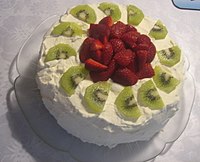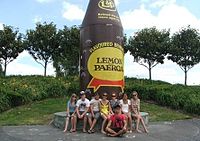Kiwiana
Kiwiana is a term used among New Zealanders to describe the objects, characters, language and cultural customs that make up New Zealand identity and national feeling.
Kiwiana
New Zealand national customs have developed from the traditions of the Europeans and the Māori since around the middle of the 19th century . The term Kiwiana refers to New Zealand's culture and history and defines national identity. It defines what it means to be a kiwi , as the people of New Zealand often call themselves.
Different cultural origins are only marginally important to Kiwiana. However, the strength of the identification is different.
To be considered a Kiwiana, something has to be particularly typical of New Zealand and associate a positive image. However, due to globalization , some New Zealanders fear a weakening of the national identity that Kiwiana wants to maintain. On the other hand, however, national identity can also be changed.
eat
Pavlova
In Southeast Asia and Oceania, the Pavlova cake has only been baked since the visit of the eponymous ballet dancer Anna Pavlovna Pavlova . Pavlovas are made from egg white, sugar, salt, vanilla extract, corn starch and vinegar and are often eaten with kiwi fruit, strawberries and / or cream for Christmas . It is debatable whether the cake was first made in New Zealand or Australia. The oldest documented recipe currently comes from New Zealand, which is why New Zealand is specified as the country of origin in the Oxford Dictionary .
Lemon & Paeroa (L&P)
Lemon & Paeroa is a lemonade-like drink only available in New Zealand that was first produced in Paeroa . Lemon & Paeroa was originally made from lemon juice and mineral water from Paeroa, hence the name. Nowadays, L&P is owned by Coca-Cola but is still popular. L&P was first produced by Menzies and Company in 1907 and manufactured in Paeroa until around 1970. the city has gained some fame for the drink and has set up a large bottle to visit to promote tourism.
Hokey Pokey
Hokey Pokey is a candy that is often eaten with ice cream or offered directly as "Hokey Pokey ice cream", vanilla ice cream with small balls made from Hokey Pokey.
Kiwi fruit
The originally from China Kiwi has great significance for New Zealand, today, most Kiwis are cultivated here. Around 1959 the fruit was first called "kiwifruit" because the New Zealanders wanted a characteristic name for the fruit and, in their opinion, the fruit was somewhat similar to the kiwi bird .
ANZAC biscuits
ANZAC Biscuits are Australian and New Zealand biscuits. ANZAC stands for the Australian and New Zealand Army Corps , which was on duty in the First World War . The name comes from the fact that the biscuits were intended for soldiers in Europe and therefore did not contain eggs, for example, in order to keep them longer. Today they mostly contain coconut . They are particularly popular on ANZAC Day .
Weet Bix
Although weet-bix are from Australia, they are also popular in New Zealand. Weet-Bix are made of wheat and are similar to Weetabix . There is the phrase "I hope he's had his weet-bix" when it comes to athletes' performance.
Pineapple lumps
Pineapple Lumps are pineapple-flavored, chocolate-coated candies that have been produced since 1935 and are only available in New Zealand.
Jaffas
Jaffas are small balls made of chocolate that have an orange shell and taste like orange chocolate. They are available in Australia and New Zealand. However, the word “Jafa” (with an 'f') is used to insult people from Auckland . This then stands for “Just Another Fucking Aucklander” ( “Just Another Fucking Aucklander”).
Animals
kiwi
The symbol of New Zealand is the native kiwi . The flightless bird is the heraldic animal of New Zealand and is a protected species. Other native New Zealand birds are the pukeko (a subspecies of the purple chicken ), kaka , takahe , kakapo , ornamental bird, tui, and the kea . Although they are protected, they can be seen quite often.
Sheep
New Zealand is the second largest wool producer in the world after Australia. With 45 million sheep, New Zealand has about eleven times as many sheep as humans, and the sheep industry has an important position in New Zealand. In addition to wool, New Zealand also exports lamb all over the world.
additional
Buzzy Bee
Buzzy Bee is a wooden toy from New Zealand that has been popular there for decades. However, the production and materials have changed, and most of the manufacturing now takes place in Shanghai .
rubber boots
Since wellington boots are widely worn on the myriad of farms and farms in New Zealand, they are also used for national identity. The place Taihape in the middle of the North Island is also called the rubber boot capital of the world, with which it represents the agricultural places. There is also a large corrugated iron rubber boot that also attracts tourists.
Sports
The predominant sport in New Zealand, which has roughly the same status as football in Germany, is rugby . The male team is called All Blacks , the female Black Ferns , and the wheelchair team is called Wheel Blacks . Popular is also Netball ( Silver Ferns ), Cricket ( Black Caps ), Hockey ( Black Sticks ), football ( All Whites ), basketball (male: Tall Blacks , female: Tall Ferns ) and softball ( Black Socks ).
New Zealand proverbs
The official languages of New Zealand are Māori and English . In everyday life in New Zealand a unique colloquial language is spoken that foreigners often find difficult to understand at first and have to learn it first. Most of the following idioms are used very commonly:
- All good / All g / No worries : here you go; no problem
- Bob's your uncle : there you have it!
- Bro : Brother - very colloquial; roughly the same as the use of the American "man", often used at the end of a sentence to create a friendly atmosphere.
- Good on ya, mate / Give that man a chocolate fish! : Well done, congratulations
- She'll be right, mate : It 'll be fine / don't worry, it 'll work out
- Sweet / Sweet as / Good as gold / Beaut : Great, great, very good
- Tiki tour : joyride
- You can handle the jandal : You can do it.
- Koha : gift, donation (from the Māori language)
For more New Zealand proverbs, see List of New Zealand Words and Phrases .
Worldview
The New Zealand worldview, often called "Kiwi Ingenuity", describes a positive attitude towards a task and the alleged ability to deliver particularly good results with limited resources. Important figures in New Zealand history include inventors such as Richard Pearse , WF Hamilton, John Britten and Burt Munro .
It is also typical that compliments, own skills, achievements, etc. are downplayed. This can be recognized by frequently used sayings such as “a bit of alright” (“a little good”), which means “very good”.
Small holiday homes, called bach , usually remain in family ownership for a long time and are used especially in summer and at Christmas.
National pride and tourism
Many small towns in New Zealand have set up statues for symbolic items that can be viewed. One of the most famous examples of this are the giant corrugated iron dog and sheep figures in Tirau ( Waikato ), trout in Taupo , Gore and other cities, a kiwi fruit in Te Puke , a carrot in Ohakune , rubber boots in Taihape and an L&P bottle in Paeroa .
Otorohanga is called the "Kiwiana capital", where there are special Kiwiana events and festivals. The largest kiwi bird house in the country can also be found in Otorohanga.
literature
- Stephen Barnett: New Zealand! New Zealand! : in praise of Kiwiana. Hodder & Stoughton, Auckland 1989
- Michael King: Being Pakeha. Hodder and Stoughton, Auckland, NZ, 1985
- Richard Wolfe: Classic Kiwiana: an essential guide to New Zealand popular culture. Penguin Group NZ, Auckland 2007
- Richard Wolfe: Kiwiana! : the sequel. Penguin Books, Auckland 2001
Individual evidence
- ↑ a b Kiwiana on newzealand.com
- ^ Kiwiana Super Integrated Thematic Unit . in2edu , archived from the original on February 17, 2009 ; accessed on August 25, 2014 (English, original website no longer available).
- ^ Pavlova rivalry . Te Ara - the Encyclopedia of New Zealand , archived from the original on June 6, 2007 ; accessed on August 25, 2014 (English, original website no longer available).
- ^ History . Cowell's Genuine Pavlova , archived from the original on January 19, 2008 ; accessed on August 25, 2014 (English, original website no longer available).
- ^ Paeroa Celebrates 100 years of Lemon & Paeroa . Paeroa , archived from the original on January 30, 2009 ; accessed on August 25, 2014 (English, original website no longer available).
- ↑ Hokey Pokey . Chelsea , archived from the original on October 14, 2008 ; accessed on January 13, 2016 (English, original website no longer available).
- ↑ How Kiwiefriut Got Its Name . Archived from the original on August 10, 2011 ; accessed on January 13, 2016 (English, original website no longer available).
- ↑ anzac.govt.nz
- ↑ Christchurch Library
- ^ Richard Wolfe, Stephen Barnett: Classic Kiwiana, An essential guide to New Zealand popular culture. Penguin Books (NZ) Ltd, 2001. page 16
- ^ Virtual Oceania
- ^ Richard Wolfe, Stephen Barnett: New Zealand! New Zealand! In praise of Kiwiana. Hodder and Stoughton Ltd., 1989, p. 42
- ↑ Taihape
- ↑ a b c Claudia Daley: New Zealand Slang. Reise Know-How, Germany, 2004



